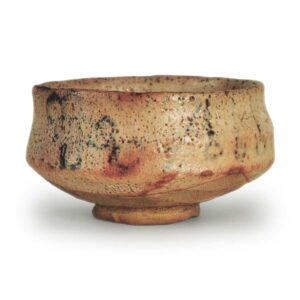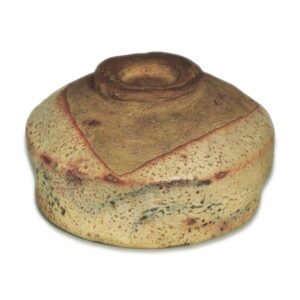

Height: 7.6-7.8cm
Diameter: 12.5-13.0cm
Outer diameter of foot ring: 5.8-6.2cm
Height of foot ring: 1.0-1.1cm
The body has a pattern of interlocking hexagons, which is probably why it is called “Kame no Oya no Yama” (Kame no Oya no Yama is a mountain in the ancient Japanese poem Kokin Wakashū, and the name is thought to be derived from the meaning of the poem “Kame no Oya no Yama no iwa ne o tomede otsu (Kirekore wo kana)”, and perhaps the slightly coiled glaze of the body was inspired by the image of ‘taki no shirotama chiyo no kazu ka mo’.
The shape is similar to that of the “Tsūten” and “Kikkōmon” styles, as well as the “Usubakuyō” style exhibited at the Daishikai Nagoya exhibition in 1965, and it is thought that they were probably all made by the same potter.
Compared to the low-waisted, half-cylindrical shapes of the Hirosawa, Sumiyoshi and Okuyama styles, these tea bowls all have a high waist and a slightly short, slightly curved body. The difference in style from the half-cylindrical shapes may be due to differences in the firing period, but it may be more appropriate to see it as a difference in the artist’s intention. Furthermore, these types of tea bowls are characterized by the reddish color that appears on the entire surface of the glaze, as is most noticeable in the “Tsūten” bowl.
The base, which has a soft-tasting clay surface, has a slightly thick foot ring, which is probably a foot ring, and from the foot ring, it has a gentle curve to the waist, and the body is arched on one side and has a slight constriction in the middle, and it reaches the rim. The rim is almost flat, and the inside gradually deepens towards the center.
The body is decorated with a tortoiseshell pattern, a ring-shaped pattern, and a picture of a mountain path on three sides, but the lines are rather thin, giving it a different flavor from the large, straightforward depictions of “Sumiyoshi” and “Okuyama”. In particular, the arrangement of the tortoiseshell pattern gives a sense of delicate movement.
Overall, the Shino glaze is quite thick, but in some places it looks a little thin, and the holes from the air bubbles are visible all over. The area around the ring-shaped pattern has a really pleasant feel, with a softness and a glossy glaze.
As is usual, the foot ring is centered on the triangle of the clay surface, which is slightly yellowish, and the reddish color at the border between the clay and glaze is also clear and vivid. The reddish color around the rim and waist is also warm and inviting, and the overall glaze, which shows a variety of different effects, is inexhaustible.
It was originally owned by Masuda Dono, then passed into the possession of Morikawa Joshun’an of Nagoya, and then to the current owner, but the history of the piece before Dono and the author of the inscription on the box are unknown.



